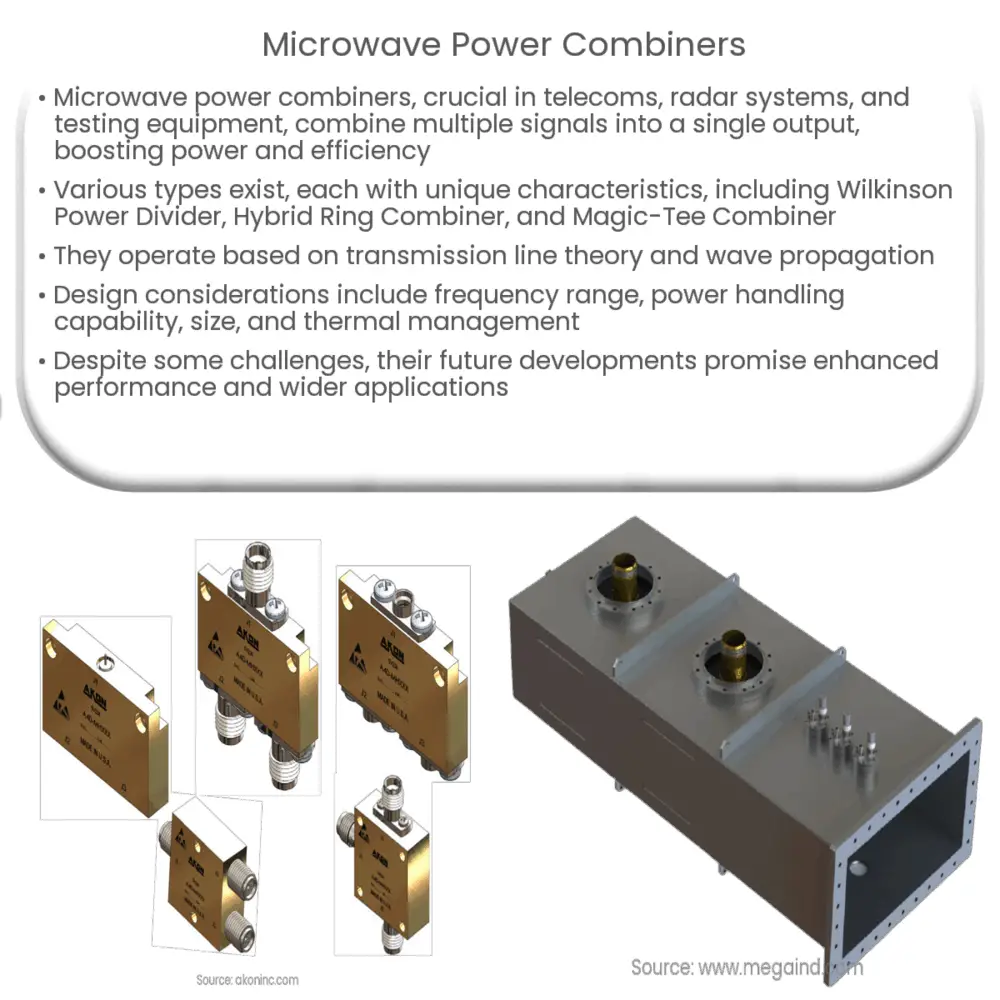Microwave power combiners efficiently merge multiple input signals into one, enhancing performance in telecom, radar, and test equipment.

Microwave Power Combiners: Enhancing the Efficiency and Performance of Modern Systems
Introduction
Microwave power combiners play a crucial role in a wide range of applications, including telecommunications, radar systems, and test equipment. These devices allow for the combination of multiple input signals into a single output signal, increasing the overall power and efficiency of the system. This article provides an in-depth look at the different types of microwave power combiners, their working principles, and their application in various industries.
Types of Microwave Power Combiners
There are several types of microwave power combiners, each with its own unique characteristics and design principles. Some of the most common types include:
- Wilkinson Power Divider: A widely-used passive device that evenly splits or combines power between two transmission lines. It is characterized by low insertion loss, good isolation, and a simple structure.
- Hybrid Ring (Rat Race) Combiner: A 3-dB quadrature coupler that is used to combine or split power between four transmission lines. It offers low insertion loss, good isolation, and excellent phase and amplitude balance.
- Branch Line Coupler: A 3-dB quadrature coupler that utilizes quarter-wavelength transmission lines to split or combine power between two input ports. It features low insertion loss, good isolation, and a compact design.
- Magic-Tee (Magic-H) Combiner: A four-port device that combines or splits power using a combination of E-plane and H-plane coupling. It provides high isolation, low insertion loss, and excellent phase and amplitude balance.
Working Principles of Microwave Power Combiners
Microwave power combiners operate based on the principles of transmission line theory and wave propagation. They are designed to ensure that power is efficiently transferred from the input ports to the output port with minimal loss and maximum isolation between input ports. Key factors to consider in the design of a microwave power combiner include:
- Insertion Loss: The reduction in power as the signal passes through the device. Lower insertion loss leads to higher efficiency and improved system performance.
- Isolation: The degree to which input signals are separated from each other. Good isolation helps prevent unwanted interaction between signals and reduces the potential for distortion or interference.
- Phase and Amplitude Balance: The consistency of phase and amplitude between input and output signals. Maintaining balance is essential for ensuring accurate and reliable signal transmission.
Applications of Microwave Power Combiners
Microwave power combiners find application in various industries and systems where efficient power combining is essential for optimal performance. Some examples include:
- Telecommunications: Power combiners are used in base stations and repeaters to combine signals from multiple antennas, improving coverage and signal quality.
- Radar Systems: In radar systems, power combiners help to combine signals from multiple transmitters, increasing the effective radiated power and detection range.
- Test Equipment: Power combiners are employed in test setups to combine signals from multiple sources, enabling the evaluation of system performance under various conditions.
Design Considerations for Microwave Power Combiners
When designing microwave power combiners, several factors need to be taken into account to ensure optimal performance and efficiency. Some of these considerations include:
- Frequency Range: The operating frequency range of the power combiner must be compatible with the system requirements. This ensures efficient signal combining across the desired frequency spectrum.
- Power Handling Capability: The power combiner should be designed to handle the maximum input power levels without causing damage or degradation in performance. This is particularly important in high-power applications, such as radar systems.
- Size and Weight: The size and weight of the power combiner should be minimized to allow for easy integration into the system. Compact designs are especially important for portable and space-constrained applications.
- Thermal Management: Efficient thermal management is crucial to ensure the power combiner operates within safe temperature limits and maintains its performance over time. This may involve the use of heat sinks, thermal vias, or other thermal management techniques.
Challenges and Future Developments
Despite the numerous advantages offered by microwave power combiners, there are still challenges that need to be addressed to further enhance their performance and expand their application scope. Some of these challenges include:
- Higher Frequency Operation: As the demand for higher frequency communication systems grows, there is a need to develop power combiners capable of operating at millimeter-wave frequencies with minimal loss and optimal performance.
- Improved Integration: Developing power combiners that can be easily integrated with other components, such as antennas and amplifiers, will lead to more compact and efficient systems.
- Materials and Fabrication Techniques: The development of new materials and fabrication techniques can help improve the performance and reliability of microwave power combiners, enabling their use in more demanding applications and environments.
Future advancements in microwave power combiners are expected to result from ongoing research and development efforts, addressing these challenges and paving the way for new applications and improved system performance.
Conclusion
Microwave power combiners play a vital role in modern systems by enhancing the efficiency and performance of various applications, such as telecommunications, radar systems, and test equipment. Understanding the different types, working principles, and design considerations of these devices is essential for engineers and system designers to optimize their performance and integration. As technology continues to evolve, further advancements in microwave power combiners will enable new applications and improved system performance, meeting the ever-growing demands of the industry.

